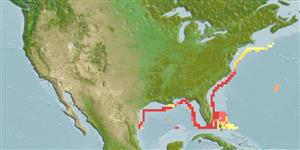>
Pleuronectiformes (Flatfishes) >
Bothidae (Lefteye flounders)
Etymology: Monolene: Greek, monos = one + Greek, lenos, ou = cavity in the skull (Ref. 45335).
More on author: Norman.
Environment: milieu / climate zone / depth range / distribution range
Ökologie
seewasser demersal. Subtropical; 42°N - 24°N
Western Atlantic: Canada (Ref. 5951) to Georges Bank to Florida, USA and northern Gulf of Mexico. Reported from the northern coast of South America (Ref. 5217).
Size / Gewicht / Alter
Maturity: Lm ? range ? - ? cm
Max length : 11.8 cm NG Männchen/unbestimmt; (Ref. 36453)
Life cycle and mating behavior
Geschlechtsreife | Fortpflanzung | Ablaichen | Eier | Fecundity | Larven
Robins, C.R. and G.C. Ray, 1986. A field guide to Atlantic coast fishes of North America. Houghton Mifflin Company, Boston, U.S.A. 354 p. (Ref. 7251)
IUCN Rote Liste Status (Ref. 130435: Version 2024-2)
Bedrohung für Menschen
Harmless
Nutzung durch Menschen
Tools
Zusatzinformationen
Download XML
Internet Quellen
Estimates based on models
Preferred temperature (Ref.
123201): 14.8 - 22.3, mean 19 °C (based on 8 cells).
Phylogenetic diversity index (Ref.
82804): PD
50 = 0.5005 [Uniqueness, from 0.5 = low to 2.0 = high].
Bayesian length-weight: a=0.00759 (0.00355 - 0.01619), b=3.08 (2.90 - 3.26), in cm total length, based on LWR estimates for this (Sub)family-body shape (Ref.
93245).
Trophic level (Ref.
69278): 3.5 ±0.4 se; based on size and trophs of closest relatives
Widerstandsfähigkeit (Ref.
120179): mittel, Verdopplung der Population dauert 1,4 - 4,4 Jahre. (Preliminary K or Fecundity.).
Fishing Vulnerability (Ref.
59153): Low vulnerability (10 of 100).
